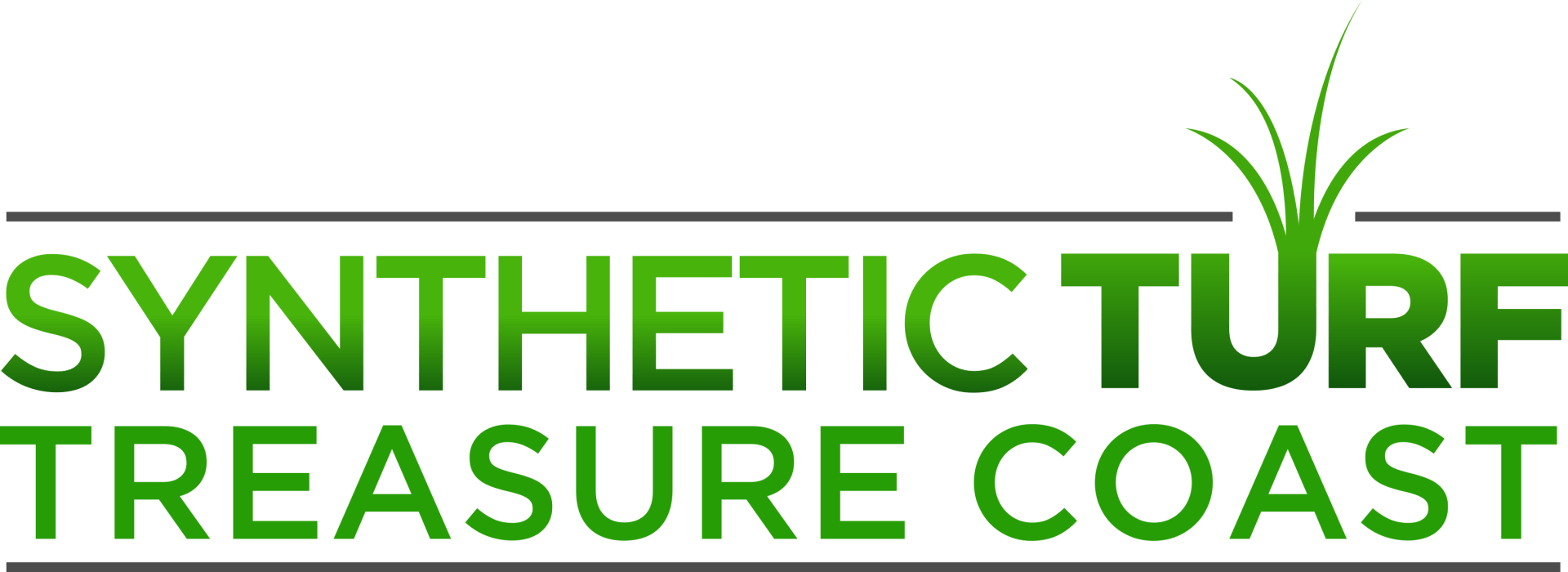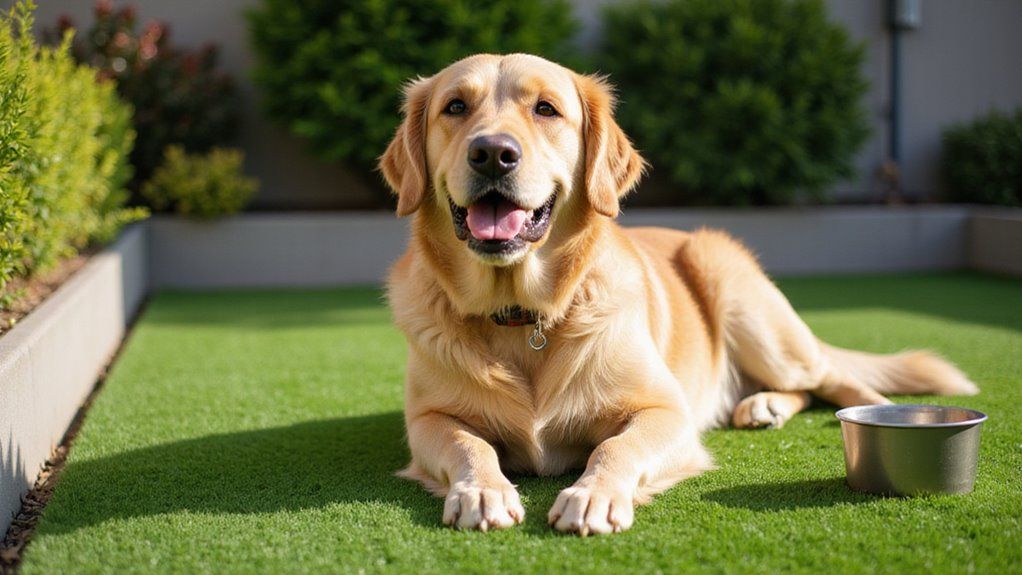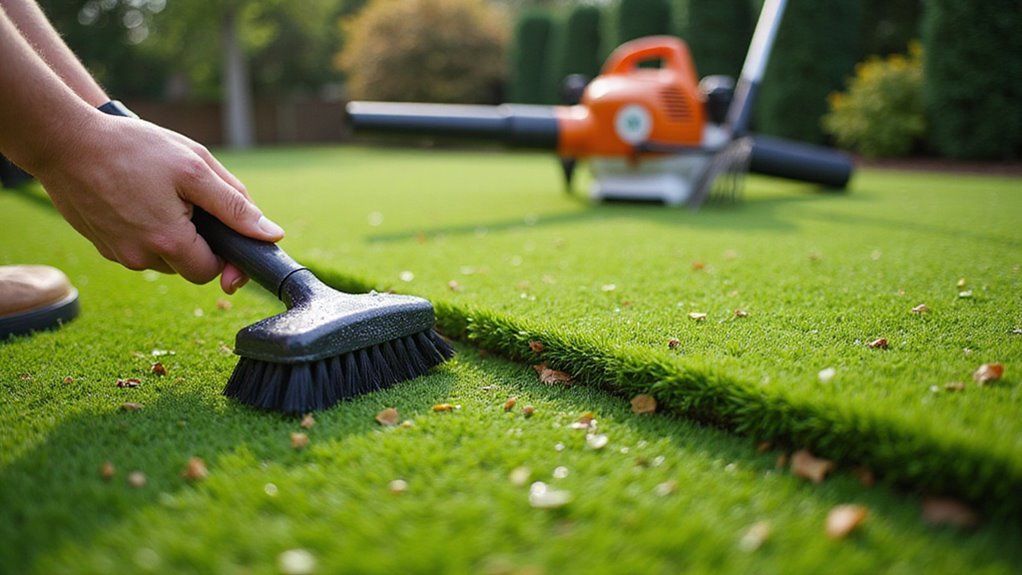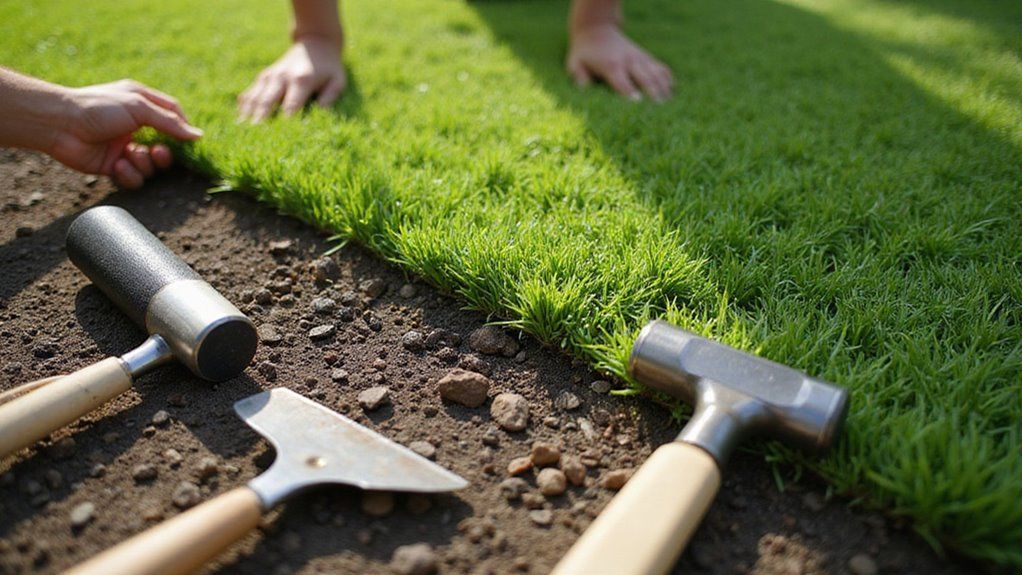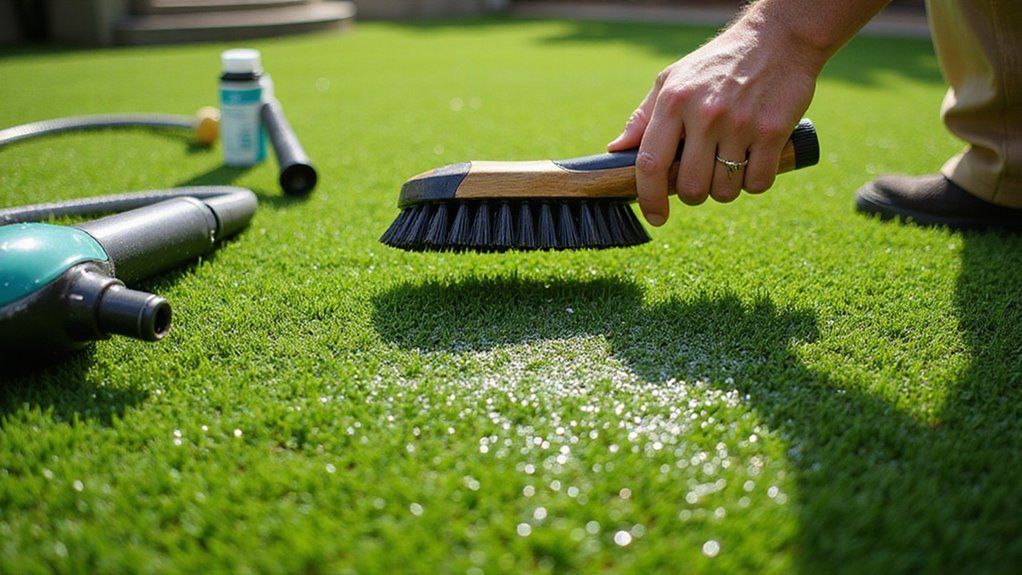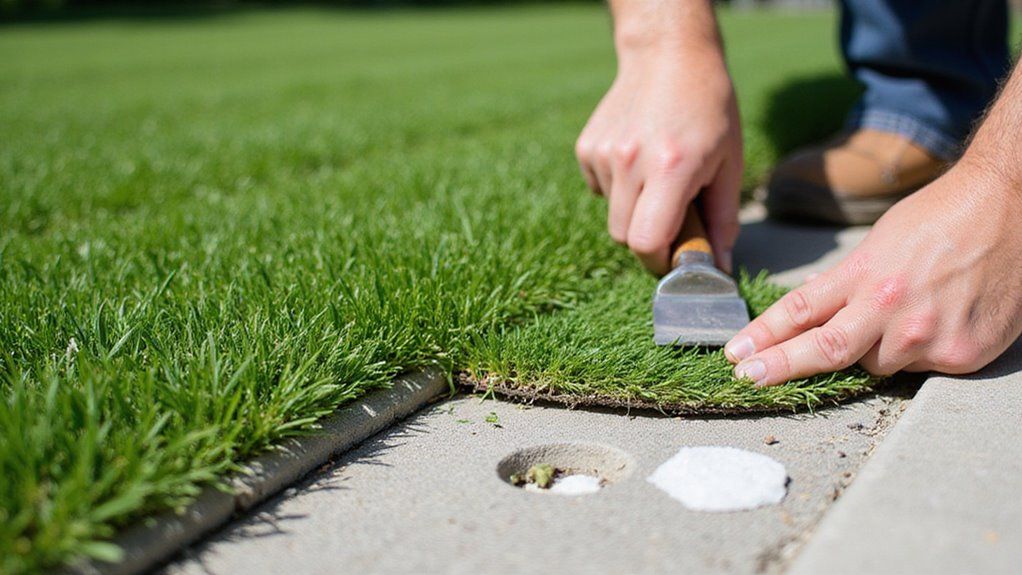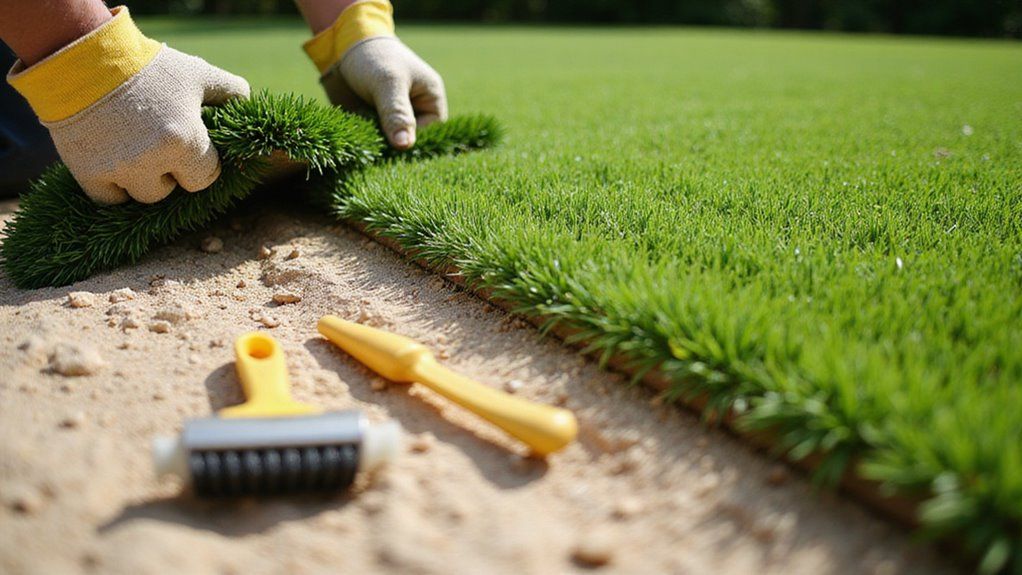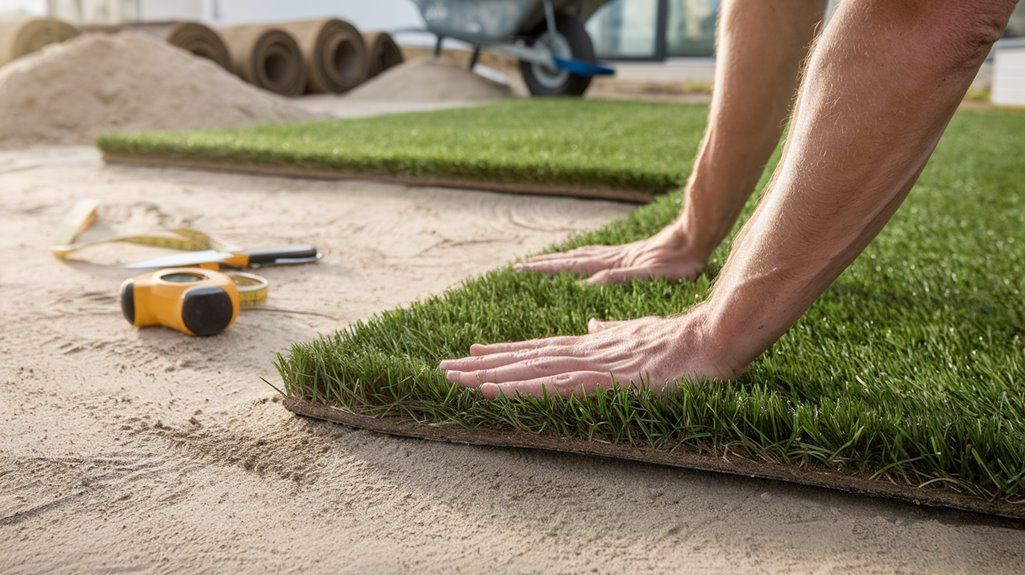Does Artificial Grass Get Hot

Stepping onto artificial grass on a hot summer day can shock your bare feet with unexpected heat. Many homeowners install synthetic turf for its low maintenance benefits without realizing the temperature issue. Your beautiful artificial lawn can become virtually unusable during the hottest parts of summer days when temperatures soar.
This heat problem isn't merely uncomfortable—it's potentially dangerous. Children and pets are particularly vulnerable to burns from superheated surfaces. The synthetic materials absorb and retain heat differently than natural grass, creating a significant temperature difference that impacts your outdoor enjoyment.
Yes, artificial grass does get hot—typically 60-70°F hotter than natural grass in direct sunlight. However, several effective cooling solutions exist for synthetic lawns.
Specialized infills, regular watering, shade structures, and proper installation techniques can significantly reduce surface temperatures.
This guide explores why artificial grass heats up and provides practical strategies to keep your synthetic lawn cool and comfortable year-round.
Key Takeaways
- Artificial grass can reach temperatures 40-60°F higher than natural grass under direct sunlight.
- Surface temperatures of artificial turf often exceed 150°F on hot summer days, posing health risks.
- Synthetic materials absorb and retain heat while natural grass cools itself through transpiration.
- Fiber type affects heat retention: polyethylene fibers are coolest, while nylon fibers hold heat longer.
- Cooling solutions include water misting systems, specialized infills, and shade structures to reduce surface temperatures.
The Science Behind Artificial Grass Heat Retention
Artificial grass gets much hotter than natural grass because of what it's made from. The plastic materials absorb sunlight instead of reflecting it away. Natural grass stays cooler because plants release water through their leaves.
Sunlight warms up the dark backing and infill materials throughout the day. These materials store heat and can't cool down easily. The temperature of fake grass can climb 40-60°F higher than the air around it.
Plastic grass fibers act like insulators that trap heat above the ground. The dense arrangement of artificial blades also blocks air movement. Surface temperatures can reach dangerous levels during hot weather, making cooling technologies like reflective coatings and specialized infill materials increasingly important for safety. If you want cooler outdoor surfaces, natural grass would be a better choice.
Temperature Comparison: Artificial vs. Natural Grass
Artificial grass surfaces can reach temperatures 40-60°F higher than natural grass under direct sunlight, with measurements showing artificial turf often exceeding 150°F on hot summer days. You'll notice that natural grass cools itself through transpiration, while synthetic materials soak up and emit heat without this biological cooling mechanism.
Your local climate conditions—including humidity levels, cloud cover, and prevailing winds—will significantly affect the temperature differential between the two surface types, with artificial grass performing better in cooler, cloudier environments. This heat retention can create health risks for children and pets playing in pool areas during peak sun exposure.
Surface Temperature Measurements
Artificial turf gets much hotter than natural grass in sunlight. Tests show synthetic turf reaching 150-180°F on summer days. Natural grass stays cooler at 90-105°F in the same conditions.
This happens because artificial grass captures more solar heat. Synthetic materials lack the cooling effects that natural grass provides. The heat difference can be felt when walking on both surfaces.
Several factors affect how hot artificial turf becomes. Dark-colored fibers absorb more heat than lighter ones. Rubber infill gets hotter than sand infill. Thicker backing materials can trap more heat underneath.
Temperature peaks usually occur in mid-afternoon. The hottest time is between 1-4 PM. If you measure at different times, you'll notice significant temperature changes.
Heat Retention Differences
Natural grass cools quickly after sunset. Artificial turf holds heat much longer because of its materials. You might feel the warmth on synthetic lawns hours after the sun goes down.
Artificial grass cannot cool itself like real grass does. Living grass releases moisture through its blades to stay cool. The synthetic backing and infill in fake grass trap heat well.
These differences become clear during evening hours. Natural grass reaches the surrounding air temperature fast. If you walk barefoot at night, artificial turf can still be 5-10°F warmer.
Climate Impact Factors
Your region's weather directly affects how hot artificial turf gets compared to natural grass. Synthetic surfaces can become 40-65°F hotter than grass during sunny days.
This temperature gap is most noticeable when air temperatures are already high.
Humidity makes a big difference in how surfaces cool down. Natural grass cools itself when moisture evaporates from its leaves. Artificial turf cannot cool this way, so it stays hotter regardless of humidity levels.
Dry areas present challenges for both surface types. Natural grass needs regular watering to maintain its cooling ability in arid regions. Without enough water, even real grass will get uncomfortably hot.
Wind helps reduce surface temperatures on artificial fields. Breezy locations may experience some cooling of synthetic turf throughout the day. Fields sheltered from wind will stay hotter longer, sometimes remaining warm well into the evening.
Peak Heat Times for Synthetic Turf
Artificial grass gets hottest between 11:00 AM and 4:00 PM during summer. The sun's position and weather conditions affect these temperature patterns. Grass temperatures rise and fall with sun exposure.
Surfaces can become 50-70°F hotter than air temperature from noon to 2:00 PM. Clear days make turf much hotter than cloudy days. Rain cools the surface briefly before it heats up again.
Synthetic turf cools down slowly after sunset. It holds heat longer than natural grass does. If you know these patterns, you can plan safer times to use your artificial lawn. The heat buildup issue is one of the major drawbacks of artificial grass, making it uncomfortable for people and pets during peak sunshine hours.
Health and Safety Concerns for Children and Pets
Children and pets face significant risks of thermal burns when artificial turf temperatures exceed 120°F, requiring immediate attention to prevent painful blisters and tissue damage.
You'll need to implement precautionary measures such as scheduled play times during cooler periods, protective footwear for both children and pets, and regular hydration breaks to mitigate heat stress.
Professional installation of cooling infills and shade structures can further reduce surface temperatures by 20-30°F, creating safer recreational environments during summer months. Additionally, proper field maintenance tasks like brushing and grooming help prevent uneven surfaces that could contribute to heat retention and potential safety hazards.
Temperature-Related Skin Burns
Artificial grass can get very hot and cause skin burns and heat stress. Burns can happen when surfaces go above 120°F and someone touches them for just 3 seconds. Turf can reach 180°F in summer months, making it dangerous to touch.
Children have thinner skin, so they get burned more easily than adults. Pets' paw pads can blister quickly on hot surfaces. Babies who crawl on hot turf may get burned right away.
Older people might not feel the heat fast enough to avoid getting burned. Always check how hot the surface is before letting anyone touch it. This is most important during the middle of the day when the sun is strongest.
Heat Stress Prevention
Extreme heat on artificial turf can harm people. Schedule activities during cooler morning or evening hours to reduce risk. Rest breaks in shaded areas are essential when temperatures rise.
Hydration stations must be available for everyone. Children and pets need special attention because they can't cool down easily. Water your turf before hot hours to lower surface temperature by 25-30°F.
Light-colored infill materials help keep turf cooler. Some turf products have special cooling technology that works better in hot weather. If you install shade structures over play areas, people will be safer during peak heat.
Material Differences and Their Impact on Heat
Different artificial grass types retain heat differently. The materials used affect how much heat they absorb and hold. These differences cause varying temperatures when different turfs are placed in the same conditions.
Polyethylene fibers create the coolest surfaces. They reflect more sunlight and conduct less heat. These fibers can be 10-15°F cooler than other options.
Nylon fibers last longer but hold heat for extended periods. This can make the surface too hot to touch. If you prioritize durability over comfort, nylon might be your choice.
Polypropylene fibers have medium heat retention. They don't last well in areas with heavy foot traffic. You should avoid using them where many people walk regularly.
Infill materials also affect temperature.
Rubber crumb infills make artificial grass much hotter. Silica sand and organic infills can lower surface temperatures by 10-20°F.
Some manufacturers now offer artificial grass with cooling technology specifically designed to address heat concerns in tropical or high-temperature environments.
Cooling Solutions for Existing Artificial Lawns
You can significantly reduce your artificial lawn's temperature with strategically installed water misting systems that provide regular cooling during peak heat hours.
Specialized cooling infills, such as HydroChill or CoolGrass products, replace standard crumb rubber with materials designed to soak up and liberate moisture for temperature reduction of up to 50°F.
Implementing shade coverage through strategically positioned awnings, shade sails, or carefully placed landscaping elements creates cooler microenvironments that protect high-traffic areas from direct sun exposure. For optimal results in pool areas, consider using polyethylene turf which offers superior comfort for barefoot traffic while maintaining excellent drainage properties that help prevent water buildup.
Water Misting Systems
Water misting systems cool down hot artificial lawns effectively. These systems can lower surface temperatures by up to 50°F through evaporation. System performance depends on water pressure, nozzle quality, and how they are installed.
High-pressure systems (1000+ PSI) produce tiny water droplets that evaporate instantly. These systems cool your lawn without making it wet. Mid-pressure systems (500-700 PSI) offer good cooling at reasonable costs.
Automated systems turn on when your turf gets too hot. They use temperature sensors to monitor heat levels. Perimeter installations cool entire areas while using less water.
If you want the best results, talk to irrigation experts. They understand how artificial turf needs special cooling methods. They can design a system that works well in your local climate.
Specialized Cooling Infills
Cooling infills solve heat problems in existing artificial lawns. These materials replace normal rubber with options like silica sand, zeolite, or cork. They can lower surface temperatures by 20-30°F through better light reflection and water retention.
Premium cooling infills include systems that trap and release moisture when it gets hot. This natural cooling effect works exactly when you need it most. Artificial turf experts can recommend the right cooling infill for your climate and lawn use.
Installation requires removing your current infill before adding the cooling alternative. This makes it a good option for lawns that get too hot. If you want comfort during summer, these specialized infills offer an effective solution.
Shade Coverage Options
Shade structures cool existing artificial grass effectively. They create shadows over synthetic lawns to reduce surface temperatures. These solutions help people use outdoor spaces even during hot weather.
Several shade options exist for artificial turf. Retractable canopies adjust throughout the day as the sun moves. They provide cooling exactly where needed.
Pergolas with climbing vines offer natural-looking temperature reduction. Artificial shade trees block intense afternoon sun without needing water. They require no maintenance.
Sail shades made from UV-resistant fabrics create interesting architectural elements. They can lower surface temperatures by up to 30°F. Watch sun patterns across seasons before installing permanent structures.
Best Practices for Installation to Minimize Heat
Good installation helps reduce heat in artificial grass. Start with a 3-4 inch layer of crushed stone or decomposed granite. This base allows drainage and helps cool the surface through water evaporation.
Add weed barrier fabric before laying the turf. It stops plants from growing underneath and trapping heat. Choose cooling infills like Hydrochill or ZeoFill instead of regular crumb rubber.
Position the grass fibers away from afternoon sun when possible. Leave small gaps at edges for the turf to expand in hot weather. These simple steps prevent excess heat buildup.
Regular maintenance keeps artificial grass cooler. Rinse the surface often during hot periods. Brush the fibers to prevent compaction that can trap heat. Gravel base options provide a cooler surface compared to concrete or asphalt, making them ideal for areas that experience high temperatures.
Regional Considerations: Climate Impact on Synthetic Grass
Climate plays a crucial role in determining how hot your artificial grass will become, with desert regions like Arizona experiencing surface temperatures up to 40°F higher than coastal areas with similar ambient conditions. Your regional temperature patterns should significantly influence product selection, as installations in Phoenix require different cooling technologies than those in Seattle.
If you're in a hot climate zone, you'll need to implement more aggressive cooling strategies and possibly select specialized heat-resistant infills to maintain comfortable surface temperatures during peak heat periods. Modern artificial turf options provide eco-friendly alternatives to real grass while eliminating the need for water-intensive maintenance in drought-prone areas.
Hot Climates Vs Coolness
Artificial grass gets hot in the sun. Weather where you live decides how much this will affect your daily use. Coastal areas stay cooler while desert turf can become too hot to touch.
Desert regions make turf unusable during afternoons. You would need cooling solutions to enjoy your yard. Mountain areas have big temperature changes but natural shade helps.
Humid areas feel worse because moisture traps heat. Your discomfort increases even at lower temperatures. Coastal installations benefit from sea breezes and milder conditions.
If you live in sunny places, look for turf with higher solar reflectivity. These special products reflect sunlight instead of absorbing it. They can make a big difference in how comfortable your artificial grass feels.
Regional Temperature Variances
Different US regions have unique temperature patterns affecting artificial turf. Southwest summers often exceed 100°F, making synthetic surfaces reach 180°F. Natural grass stays cooler in the same conditions.
Northern states have milder summers but extreme seasonal changes. These changes can affect turf durability and heat retention. Coastal areas benefit from ocean breezes that keep artificial grass cooler.
Humidity levels in your location also matter. High humidity areas might have less extreme surface temperatures. However, these areas cool down more slowly once heated.
You should understand your regional climate before selecting artificial grass. This knowledge helps you choose appropriate products. It also guides installation details that reduce heat buildup.
Infill Options That Affect Temperature
Certain infill materials can make your artificial turf cooler or hotter. The material you choose determines how much heat gets trapped or released. Infills that hold water can cool your turf through evaporation.
Silica Sand offers few cooling benefits. It can make your turf up to 20°F hotter than the surrounding air. Many sports fields use this traditional option despite its heat retention.
Crumb Rubber traps excessive heat in your turf. Surface temperatures may rise 30-50°F above the ambient air temperature. Athletes often complain about the extreme heat when playing on rubber-filled fields.
Zeolite Infill can absorb water up to 12% of its weight. This water retention provides cooling effects that last 2-3 days after watering. Your turf will feel more comfortable during hot weather with zeolite.
Cork Infill naturally insulates against heat transfer. It can lower surface temperatures by 10-15°F compared to rubber infills. Cork would be ideal if you live in a hot climate.
Using synthetic turf with appropriate infill materials provides environmental benefits while maintaining comfortable outdoor spaces during hot weather.
The Role of Color and Blade Design in Heat Absorption
Light-colored artificial turf blades can reduce heat absorption by up to 15°F. Lighter colors reflect more sunlight back into the atmosphere. They convert less solar energy into heat compared to darker green options.
Blade design affects turf temperature too. Modern "cool grass" technologies use heat-reflective pigments in the fibers. C-shaped or S-shaped blades create tiny air channels that help heat escape.
Flat blade designs trap more heat between strands. The specialized shapes improve airflow throughout the turf system. This better airflow helps lower overall surface temperatures.
People in hot climates should choose turf with reflective technology. Lighter green colors work best for heat reduction. If you combine optimized blade shapes with lighter colors, your turf will stay cooler.
UV protection coatings prevent color fading while also contributing to the heat resistance properties of premium artificial grass options.
Watering Techniques to Cool Artificial Surfaces
Water can cool down hot artificial grass by 30-50°F in just minutes. You should spray your synthetic lawn during hot weather to keep it comfortable. This helps both pets and family members use the space safely.
Morning is the best time to water your artificial grass. Set your sprinklers to spray lightly between 6-8am before the day gets hot. This timing allows the surface to cool down properly.
Short bursts of water work better than long watering sessions. Try using 2-3 minute sprays instead of one long soak. This method saves water while still cooling the surface effectively.
Some areas of your lawn need more water than others. Focus on spots that get direct sunlight throughout the day. High-traffic zones should also receive extra attention.
You should change your watering schedule based on weather forecasts. If several hot days are coming, increase your watering frequency. This prevents the surface from becoming too hot.
Automated systems can make watering easier and more efficient. Look for systems with moisture sensors to avoid overwatering. These tools ensure your artificial grass gets exactly what it needs.
Shade Strategies for Reducing Surface Temperatures
Shade can cool your artificial grass by 20-30°F during hot days. Trees, pergolas, and shade sails block direct sunlight from heating up the surface. These solutions work better than water, which only cools temporarily.
Retractable awnings offer flexible coverage during peak heat hours. You can extend them when the sun is strongest and retract them in cooler periods. Western and southern areas need the most shade since they get intense sunlight.
Fast-growing trees like maples or poplars create natural shade patterns. You should plant them at safe distances to protect your turf from root damage. If trees aren't an option, fabric shade sails can be installed more quickly.
Good airflow helps remove heat from your artificial grass. Arrange shade structures with small gaps between them for better ventilation. If you combine partial shade with proper air circulation, your turf will stay significantly cooler.
Long-Term Heat Management for Synthetic Lawns
Artificial lawns need planning to stay cool over time. Smart design choices work better than fixing heat problems later. These strategies help your lawn remain comfortable for years.
Good materials make a big difference in lawn temperature. New yarns can reflect more sunlight away from your grass. Some infills hold water and cool the surface when water evaporates.
Cooling systems under the turf create air flow to reduce heat. Special backing materials help spread heat out instead of trapping it. These features work throughout the entire lifespan of your lawn.
These cooling options cost more at first but provide better results. Most synthetic lawns last 15-20 years with proper care. If you invest in cooling technology now, your outdoor space will stay usable even during hot weather.
New Technologies in Heat-Resistant Artificial Grass
Modern artificial grass now handles heat much better. Heat-reflective fibers can lower surface temperatures by up to 30%. These fibers deflect sunlight instead of absorbing it.
Natural infills have replaced rubber in many installations. Cork and walnut shells keep the turf cooler than traditional materials. They also improve cushioning and help water drain faster.
Better ventilation systems make a big difference in temperature control. New turf backing contains tiny channels for air movement. Heat escapes through these pathways when paired with cooling infills.
These advances make artificial grass more comfortable in hot weather. You can enjoy the convenience without worrying about scorching surfaces. If you install these newer systems, your outdoor space will stay usable even during summer.
Conclusion
Artificial grass does get hotter than natural grass during sunny days. The synthetic materials absorb heat more readily than living plants. However, several practical solutions can help manage this heat issue effectively.
If you're concerned about heat, consider installing lighter colored turf or specialized cooling infills. Regular spraying with water can quickly cool down hot surfaces. Modern artificial grass products now include heat-resistant technologies that reduce temperature buildup.
Your comfort matters when enjoying outdoor spaces in warm weather. With proper installation and maintenance, artificial grass can remain comfortable year-round. Install Your Artificial Grass with Synthetic Turf Treasure Coast for a beautiful, functional lawn that stays cooler in the heat.
About the author
Kathy Leavell
Kathy Leavell is the founder and owner of Synthetic Turf Treasure Coast, a leading provider of synthetic grass solutions for residential and commercial properties in Florida. With over a decade of experience in the industry, Kathy has become a recognized expert in synthetic turf installation, maintenance, and repair. Under her leadership, Synthetic Turf Treasure Coast has earned a reputation for exceptional customer service and high-quality workmanship.
Prior to starting her own business, Kathy worked in sales and marketing roles at several major synthetic turf manufacturers.
